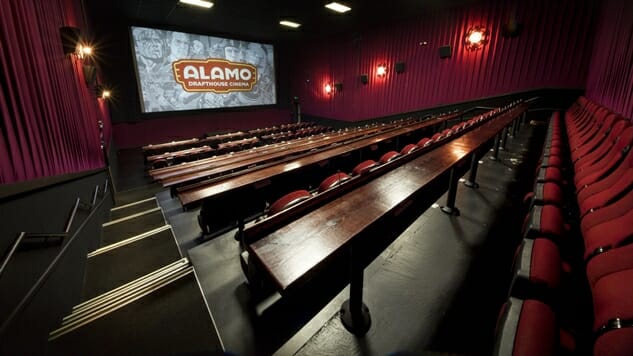How Alamo Drafthouse Is Changing the Moviegoing Experience
Photo credit: Nick Simonite Business Features alamo drafthouse
Netflix CEO Reed Hastings couldn’t resist a bit of industry smack talk during a March Q&A session with reporters, when he cracked that big cinema chains seem so bereft of ideas, that innovation to them means just making the popcorn taste better.
That didn’t go over so well with Tim League, the founder and chief executive of Alamo Drafthouse. He may not have Netflix’s fat pile of cash or its tens of millions of subscribers, but League’s scrappy independent chain has plenty else going for it instead—strengths that it’s used to grow from one screen in Austin to 26 locations around the country today, with more to come later this year.
How has he and Alamo done it, at a time when it seems like consumers have more reason than ever to watch movies on demand instead of with a bunch of strangers in the dark? Answer: Alamo keeps expanding its footprint—and has even ventured into side projects, like the sale of movie memorabilia and film distribution—because League knows the true film buffs out there want that one thing the creeping digitization of the world seems to make more elusive than ever.
It’s the experience, something League and his crew have always sweated the details to be able to give to Alamo patrons, which is one reason he found Hastings’ comments a bit inartful, to say the least.
“I don’t think we’re as stagnant as (Hastings) painted us out to be,” League said in an interview with Paste about Alamo, which in May will celebrate the 20th anniversary of the opening of its first location, back when the first day consisted of a double feature showing of Raising Arizona and Spinal Tap.

Photo credit: Annie Ray
The company also plans to open six more locations in the months ahead. Its playbook is built around curated movie showings and food and drink menus that lean heavily on local tastes and culinary talent in their respective cities. Alamo also has a famously strict zero-tolerance policy for talking and cell phone use during shows. And patrons aren’t subjected to a barrage of ads before the trailers; Alamo produces its own pre-show content.
Each location also has a bar where moviegoers can head to for drinks and conversation after the show. Local chefs bring signature touches to each Alamo cinema’s menu.
If it all comes together—like, say, a well crafted piece of quality cinema—League and his merry band of movie nerds will have presented patrons with something worth putting down the phone and getting out of the house for.
“A lot of people like to point to services like Netflix, with all this great content you can get in the home, and I’m a consumer of that,” League said. “I like having that in my life. But no matter how much good stuff you have at home, there’s an urge every once in a while to get out of the home and go interact with people and have an experience. So the abstract challenge for us has to do with what I think our real competition is—which is, just everything outside of the home.”
It’s certainly an interesting way of thinking about the problem of how to make the act of physically getting one’s self to a cinema—when the smartphone is just right there—a more attractive proposition.
Alamo’s success—and the milestone it’s hitting next month—are attributable to League framing the competition in a very specific way. It’s not Alamo vs. Netflix. It’s Alamo versus, well, everything—another small saga among many in what’s essentially become one big scramble to capture your attention. Because every minute you’re scrolling your Facebook feed at home is a minute you’re not paying attention to Netflix’s Stranger Things, and every minute you’re at home watching Stranger Things is time you’re not spending with the other movie buffs at Alamo.
League, and cinema owners like him, aren’t necessarily whistling past the graveyard here. People still want the experience they offer. In 2016, moviegoers spent $11.4 billion at the box office in the U.S. and Canada, up from $11.1 billion in 2015, according to the Motion Picture Association of America.
“You’re starting to see more cinemas move in this direction,” League said. “There’s been a regime change at AMC. They’ve brought in a new CEO from the hotel and hospitality industry, and he’s making some moves to try to increase the concession offerings across the AMC brand. Moving away from homogeneity, if you will—that’s a challenging exercise.”
Tim and his wife Karrie founded Alamo as a mom and pop operation that went on to be dubbed by Entertainment Weekly as “the best theater in America.” It eventually added things like Mondo, an offshoot that creates limited edition screen printed posters for classic and contemporary films, TV shows and comics, in addition to toys, apparel and more. Alamo also has a film distribution arm.

Photo credit: Nick Simonite
With Alamo, he said, “we basically took the aesthetic of operating an arthouse theatre and developed a kind of hybrid model, where we show a really diverse palette of movies. From things like Star Wars and Marvel films all the way down to the smallest documentaries. But all the while trying to build up and foster a real relationship with our customers. And so even though we’ve expanded, we haven’t taken a cookie-cutter approach and stamped it across the U.S.
“We’ll probably open another seven or eight next year. The thing is, we always have to make sure going to the cinema is a good value proposition and a great offering and a great experience, versus going to see a concert or a play or live music or even just going to a bar.”